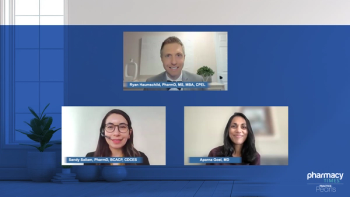
Considerations for Prophylaxis in Patients With Hemophilia A
Key opinion leaders discuss the factors in giving patients with hemophilia A prophylaxis, including any barriers and discussions with the patient.
Episodes in this series

Jonathan Ogurchak, PharmD, CSP: How exactly do you approach that? Is there a difference in how you look to approach those types of tactics for prophylaxis from primary to secondary to tertiary?
Robert Sidonio Jr., MD, MSc: We’ll often talk about continuous prophylaxis, this idea of giving it on a regular basis. The definition is a little loose, but typically you’re giving factor at least once a week, over a 3- to 6-month period vs intermittent or short-term prophylaxis, in which maybe they had a bleeding event. You’re trying to break that cycle. Oftentimes, we’re doing this for our nonsevere patients. The guidelines have come out and said that even in moderate patients, if they have a severe bleeding phenotype, they should be offered prophylaxis as well. They may be offered that secondary because you’re trying to see, is that moderate patient going to develop bleeding symptoms that you would typically see in a severe?
However, if you look at the trends, we’re obviously being more aggressive than we were even 10 years ago. Just look at our internal data sets at the American Thrombosis & Hemostasis Network [ATHN] and the Centers for Disease Control and Prevention [CDC]. At least half of our moderate patients, those with levels of 1% to 5%, are on prophylaxis for at least some period of time before the age of 18. That number was significantly lower years ago. We’re going to continue to push that we’re doing more primary prophylaxis. However, typically in a young child, you can’t start out maybe at 3 times a week, every other day, or every 48 hours or every 72 hours. That’s really hard right out of the gate. We typically start at once a week and try to get the family and the child to accept this emotionally. Then we ramp up in young children to twice a week for either Factor VIII or Factor IX, which is usually effective early on, aside from devastating bleeding events. Eventually we try to get them to a more typical strategy, which is usually about 3 times a week for standard half-life products for Factor VIII, and typically 2 to 3 times a week for Factor IX. Obviously, some extended products allow once-a-week administration.
Jonathan Ogurchak, PharmD, CSP: Great. Once prophylaxis was initiated, can that ever be discontinued? What’s that approach from there?
Robert Sidonio Jr., MD, MSc: Alexis, I’ll let you take the lead on this, then I’ll jump in.
Alexis Kuhn, PharmD, BCOP: Thanks. With prophylaxis, as we’re looking into the future and playing the long game, in an ideal state we would be continuing and reaping the benefits of the prophylaxis long term. However, as we mentioned, there are significant logistical, emotional, and physiological burdens that come with prophylaxis. Yes, in very individualized cases, absolutely, we would consider discontinuing prophylaxis if the burdens outweigh the benefits that are being realized in the individual.
Robert Sidonio Jr., MD, MSc: It’s always a compromise with the patients. There are situations where it’s just not a good time, or the child is having a really hard time with it, or a central line is the barrier to it. Young children often need some central line, even if it’s temporary, and we all know every child is different. For some kids, you could do it. Some kids learn how to stick themselves when they’re 5 years old. With some kids it takes until 12 or 13 years old. We have to be very supportive and tell people that our goal is to try to get prophylaxis. We’re trying to prevent life-threatening bleeding events. We’re trying to allow a more normal life. It’s never going to be normal, but we’re trying to get them so they can participate in life and physical activities—some sports, obviously noncontact. It’s always a negotiation, particularly in the early age. With the adults, we have to say, “We’re thinking of your long-term benefits. We want you to be functional. We don’t want you to lose your ability to infuse because you’ve had so many elbow bleeds.”
Jonathan Ogurchak, PharmD, CSP: That makes perfect sense. Now, let’s talk a little about that patient preference to approach. How does that patient preference play a role in selecting whether to go toward…therapy vs prophylactic therapy?
Anastasia Abramson, PharmD, MBA: Patient preference is certainly important in the selection of treatment and should be considered in decision-making, so we can help make the optimal treatment choice for not only favorable outcomes but sustainability in terms of adherence. It’s a little different for younger populations being managed by hemophilia treatment centers, but in older populations that have not been established on prophylaxis, we definitely see certain patient preferences and introduce prophylaxis to the treatment plan. Of course, we want to keep the patient’s personal goals in mind when selecting that approach. In terms of some patient preferences that we see at the pharmacy level, aside from cost, 1 of the concerns is for developing inhibitors against Factor VIII replacement products. We do run into adult patients who have been treating their bleeds on demand their whole lives, and when the conversation for prophylactic therapy comes up, they’re not quite comfortable taking on that risk over the benefit. Also, there’s the inconvenience of the frequency and daunting intravenous administrations with the products, but this is something we can provide education on and help make the patient more comfortable with.
Transcript edited for clarity.
Newsletter
Stay informed on drug updates, treatment guidelines, and pharmacy practice trends—subscribe to Pharmacy Times for weekly clinical insights.













































































































































































































